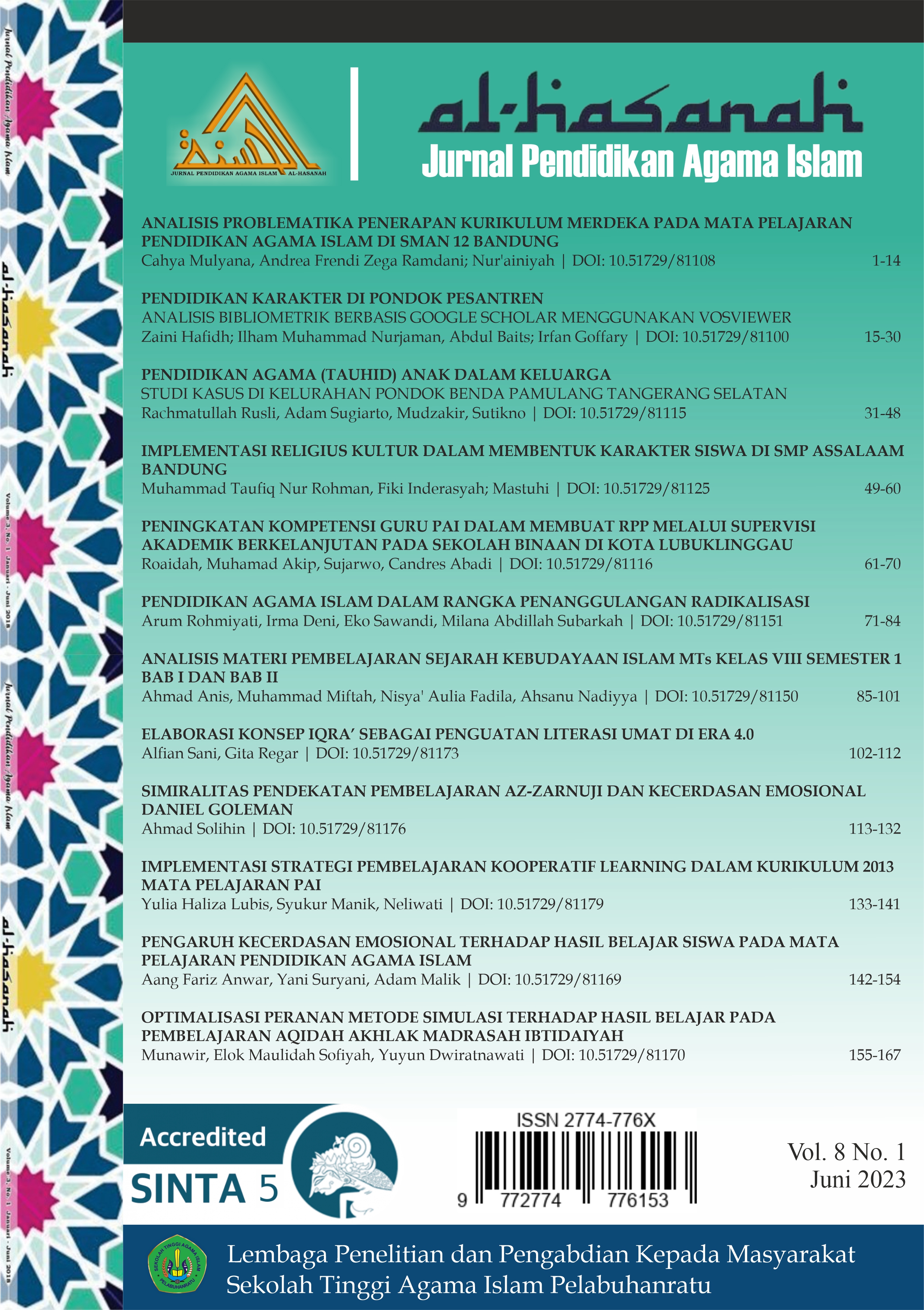ANALISIS MATERI PEMBELAJARAN SEJARAH KEBUDAYAAN ISLAM MTs KELAS VIII SEMESTER 1 BAB I DAN BAB II
DOI:
https://doi.org/10.51729/81150Keywords:
Analysis, Teaching Materials, History of Islamic CultureAbstract
History related to sequence of events and each event occurs at a certain time, likewise in Islamic history. Islamic history reveals the phenomena based on the facts of the historical development of Muslims from era to era. The purpose of this study was to analyze the contents of the teaching material of History of Islamic Culture students at the VIII grade Madrasah Tsanawiyah level published by the Indonesian Ministry of Religion in 2013 Curriculum. This study used library research, with descriptive analysis techniques through some literature. The results of this study indicate that the student book on the subject of History of Islamic Culture at the VIII grade has presented a material based on cognitive, affective, psychomotor domain, and students psychological development. Thus, it is expected that teachers can convey the material using variety methods, so that the students can easily understand and not bored, so learning goals can be achieved and improve the quality of education.
Downloads
References
Al-Faruq, M. S. S., & Sukatin. (2021). Psikologi Perkembangan. Yogyakarta: Deepublish.
Anggara, T., & Dyah, K. (2019). Analysis of Historical Material of Islamic Civilization in Historical Textbooks at High School. ATLANTIS PRESS: Advances in Social Science, Education and Humanities Research, 323, 334-340. http://dx.doi.org/10.2991/icossce-icsmc-18.2019.59
Evanirosa, et al. (2022). Metode Penelitian Kepustakaan (Library Research). Bandung: Media Sains Indonesia.
Fahrudiin, I. (2020). Analisis Buku Ajar Sejarah Kebudayaan Islam Menurut Badan Standar Nasional Pendidikan. TARLIM: Jurnal Pendidikan Agama Islam, 3(1), 15-26. http://dx.doi.org/10.32528/tarlim.v3i1.3316
Gunawan, I., & Anggarini, R. P. (2012). Taksonomi Bloom–revisi Ranah Kognitif: Kerangka Landasan untuk Pembelajaran, Pengajaran, dan Penilaian. PREMIERE EDUCANDUM: Jurnal Pendidikan Dasar dan Pembelajaran, 2(2), 98-117. http://doi.org/10.25273/pe.v2i02.50
Ifendi, M. (2020). Dinasti Abbasiyah: Studi Analisis Lembaga Pendidikan Islam. FENOMENA: Jurnal Penelitian, 12(2), 139-160. https://doi.org/10.21093/fj.v12i2.2269
Islam, M. H. (2019). Islam and Civilization (Analysis Study on the History of Civilization in Islam). AL-INSYIROH: Jurnal Studi Keislaman, 5(1), 22-39. https://dx.doi.org/10.35309/alinsyiroh.v5i1.3395
Jahja, Y. (2011). Psikologi Perkembangan. Jakarta: Prenamedia Group.
Kosasih, E. (2021). Pengembangan Bahan Ajar. Jakarta: Bumi Aksara.
Laefudin. (2017). Belajar dan Pembelajaran. Yogyakarta: Deepublish.
Natsir, N. (2017). Hubungan Psikolinguistik dalam Pemerolehan dan Pembelajaran Bahasa. RETORIKA: Jurnal Bahasa, Sastra, dan Pengajarannya, 10(1), 20-29. https://doi.org/10.26858/retorika.v10i1.4610
Nurhidayati, A., & Ernawati, S. S. (2013). Peningkatan Hasil Belajar Ranah Afektif Melalui Pembelajaran Model Motivasional. JIPTEK: Jurnal Ilmiah Pendidikan Teknik dan Kejuruan, 6(2), 112-116. https://doi.org/10.20961/jiptek.v6i2.12614
Rahmawati, L. E., & Miftakhul, H. (2022). Evaluasi Pembelajaran Bahasa Indonesia dan Sastra Indonesia. Surakarta: Muhammadiyah University Press.
Sanjaya, W. (2017). Perencanaan dan Desain Sistem Pembelajaran. Jakarta: Kencana.
Saufi, A., & Hasmi, F. (2015). Sejarah Peradaban Islam. Yogyakarta: Deepublish.
Subhan, M. (2020). Sejarah Kebudayaan Islam. Jakarta: Direktorat KSKK Madrasah, Direktorat Jenderal Pendidikan Islam, Kementerian Agama RI.
Sulaiman, H., et al. (2020). Psikologi Perkembangan Anak dan Remaja. Bandung: PT Remaja Rosdakarya.
Utama, D. G., & Hana, P. H. (2021). Pembelajaran Dinamika pada Ansambel Gitar Ditinjau dari Aspek Afektif, Kognitif, dan Psikomotor. JMEPA: Journal of Music Education and Performing Arts, 1(1), 16-22.
Widodo, H. (2021). Evaluasi Pendidikan. Yogyakarta: UAD PRESS.
Yusria, I. F. (2020). Analisis Buku Siswa “Sejarah Kebudayaan Islam” Kelas VII Madrasah Tsanawiyah Kurikulum 2013. PANDAWA: Jurnal Pendidikan dan Dakwah, 2(2), 204-217. https://doi.org/10.36088/pandawa.v2i2.708

Downloads
Published
How to Cite
Issue
Section
License
Copyright (c) 2023 Ahsanu Nadiyya, Nisya' Aulia Fadila, Ahmad Anis

This work is licensed under a Creative Commons Attribution 4.0 International License.
Authors who publish with this journal agree to the following terms:
- Authors retain copyright and grant the journal right of first publication with the work simultaneously licensed under a Creative Commons Attribution 4.0 International License. that allows others to share the work with an acknowledgement of the work's authorship and initial publication in this journal.
- Authors are able to enter into separate, additional contractual arrangements for the non-exclusive distribution of the journal's published version of the work (e.g., post it to an institutional repository or publish it in a book), with an acknowledgement of its initial publication in this journal.
- Authors are permitted and encouraged to post their work online (e.g., in institutional repositories or on their website) prior to and during the submission process, as it can lead to productive exchanges, as well as earlier and greater citation of published work.
















